Getting More Mountain Snowmobile Performance
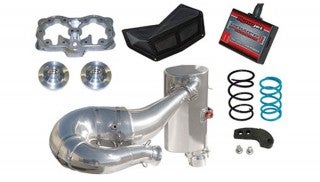
Powder-specific add-ons that will stretch your grin, not your budget
Model year 2015 delivers to the steep and deep rider some killer snowmobiles: Ski-Doo Summit X T3, Polaris RMK Pro 800, Arctic Cat Sno Pro M8000 and Yamaha SR Viper M-TX with turbocharger. One of these, the T3 Summit, comes with a factory-installed three-inch paddle track that measures 16 inches in width.
What more could you want our of these mountain kings? Well, things can always be made better. Here is a list of four suggested projects that will make your powder and mountain killing snowmobile more beastly. The products listed are meant to stretch your grin without stretching your budget.
Many mountain riders live, eat, work and breathe at elevations between 4,000 feet and 5,000 feet. From there, these riders, like the mountain wrecking crew at Snowmobile.com, go higher to ride the powder between 6,000 feet and 10,000 feet in elevation. At these heights, motor performance diminishes due to thin air. It would be wonderful to ride steep-n-deep style nearer sea-elevation – that would be Alaska.
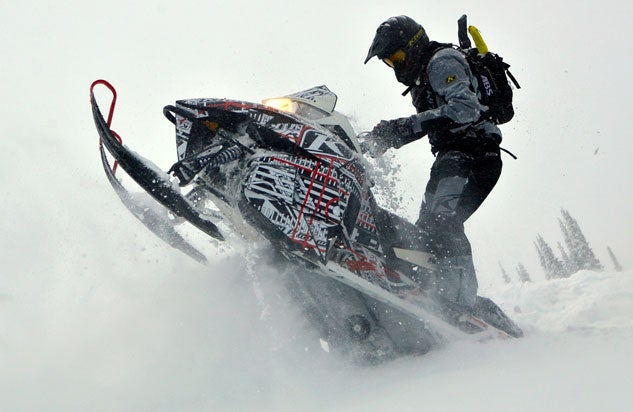 A stock Arctic Cat M8000 is a good snowmobile, but one that takes to weight loss and performance gains better than most as it has the most to gain. Dustin Pancheri, Klim Regional Sales Manager, built a 2014 M8000 with components mentioned here, that made his M8000 be all it could be, without sacrificing several truck payments.
A stock Arctic Cat M8000 is a good snowmobile, but one that takes to weight loss and performance gains better than most as it has the most to gain. Dustin Pancheri, Klim Regional Sales Manager, built a 2014 M8000 with components mentioned here, that made his M8000 be all it could be, without sacrificing several truck payments.As we’ve written many times before, depending on temperature, barometric pressure and humidity, an internal combustion motor – like those in a snowmobile – loses between three and four percent of its horsepower for every 1,000 feet gained in elevation. Hence, a 160-horsepower motor at sea level will be a 126.4 horsepower motor at 7,000 feet – conservatively.
This is the reason why Ski-Doo, Arctic Cat, Polaris, and Yamaha strive to make their mountain snowmobiles as light as possible while maintaining superb strength. The goal is a high power-to-weight-ratio. The less weight that motor has to carry, the better the performance.
What do consumers do? Well, they increase horsepower by opening up the motor’s intake and exhaust function. Other means is to add turbochargers or superchargers. These are expensive, but add much eyeball water wow to mountain riding. Other options are obtaining maximum clutch efficiency and reducing rotating mass.
This feature addresses the practical. What can you and I can do as common Joe and Joyce to make our mountain snowmobile better in the mountains without forcing us to sell one of our children? We present flotation, handling, and motor ideas that we believe are essential, that elevate your experience at high elevations.
Skis
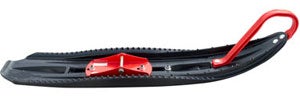 The MoHawk Ski from Starting Line Products, introduced last year, is gaining in popularity in the West for its aggressive powder characteristics and flotation.
The MoHawk Ski from Starting Line Products, introduced last year, is gaining in popularity in the West for its aggressive powder characteristics and flotation.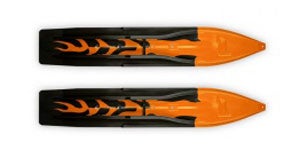 The Sly Dog Powder Hound ski, which comes in two widths, seven-inch and eight-inch, is a good choice for powder riding. These skis can be built in a gazillion color and fashion patterns for your liking.
The Sly Dog Powder Hound ski, which comes in two widths, seven-inch and eight-inch, is a good choice for powder riding. These skis can be built in a gazillion color and fashion patterns for your liking.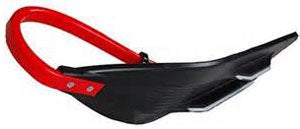 A standard in the West, the Simmons Flexi Ski is highly praised. The Gen III is Simmons’ latest and is the best tunnel ski that can money can buy. Its flotation is phenomenal.
A standard in the West, the Simmons Flexi Ski is highly praised. The Gen III is Simmons’ latest and is the best tunnel ski that can money can buy. Its flotation is phenomenal.We are not fan crazy about any Original Equipment Manufacturers (OEM) mountain/powder ski. Well, let us modify this a bit, the Gripper ski on Polaris’ RMK Pro works well, as well as the powder ski Yamaha used on its Nytro MTX, but which is no longer available.
We believe in lift, float, trail cornering, sidehill bite and aggressive steering in powder. When bounding over hill and dale in the Rockies, several aftermarket skis are often seen, which are: Mohawk and Powder Pro from Starting Line Products (SLP), Idaho Falls, ID; C&A Pro BX (Boondocker Xtreme) and MTX (Mountain and Trail for heavy four-stroke mountain snowmobiles), Hutchinson MN; the seven-inch and eight-inch wide Powder Hound from Slydog, Arlington, SD; and the Simmons Gen III Flexi Ski.
Why do you want these? The OEM ski is designed for averages, to be an average do-it-all ski, without excelling in one facet. Mountain riders want a ski that will take their sled to the next level in powder handling. Aggressive mountain skis help riders become better powder masters, and in our simple opinion, these help keep riders out of trouble, as the ski will not wash out, leading the rider and her/his sled careening into a tree or off a steep slope.
Plan on spending about US$450 for these skis, which come in pairs. When choosing an aftermarket ski, ask those who have used these, and hopefully, other competing brands. An aftermarket ski will change a mountain snowmobile’s handling characteristics. An SLP Mohawk ski on an Arctic Cat M8000 will make it behave differently than when bolted to a XM Summit X. Also know your flotation needs. The Simmons Gen III is a dual-keeled tunnel ski, where the others mentioned here are deep-center keeled ski. This will alter steering and cornering, depending on make and model. Regardless, these enhance a mountain snowmobile’s deep powder and sidehilling manners. Some may be too aggressive, some not enough. But, as mentioned earlier, study, learn, try and buy.
Pipe
One of the surest and easiest ways to drop weight from your mountain snowmobile and add power is to rip out the OEM exhaust pipe and muffler and install an aftermarket single-tuned exhaust with lightweight canister. Weight loss is from 15 to 20 pounds and you typically gain three to seven horsepower. We’ve seen some cases where a snowmobile rolled out an extra 10 horsepower, but this rare.
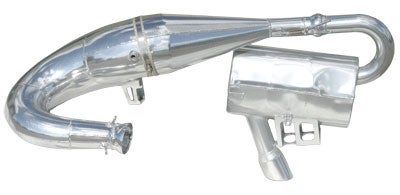 Single tuned exhausts are the simplest way to add power while dropping weight. Pipes are the best performance gains, and weight loss, for the money.
Single tuned exhausts are the simplest way to add power while dropping weight. Pipes are the best performance gains, and weight loss, for the money.You may think an additional three to seven (maybe eight) horsepower is not much, but when you factor in the weight loss, you get a noticeably improvement in power-to-weight ratio.
Choices in Aftermarket Snowmobile Skis
When choosing a single-tuned exhaust, ensure the aftermarket builder has done its research and development (R&D) on mountain snowmobiles at high elevations; we’re talking about 5,500 feet and greater. Dyno room development is a good place to start, but on the snow testing and tuning at elevation is paramount. Some aftermarket pipe kits come with a silencer (more often than not), and some may require a fuel controller to modify the motor’s EFI impulse signal for the more efficient intake and exhaust flow.
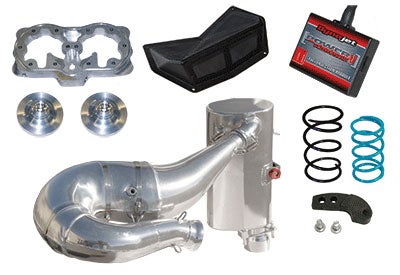 When considering more than just a pipe, some performance kits will include air intake, clutch performance, and cylinder head performance. This is optimum, but more money. Notice the fuel controller. These are needed to manage the increased fuel and oxygen flow – which the motor demands.
When considering more than just a pipe, some performance kits will include air intake, clutch performance, and cylinder head performance. This is optimum, but more money. Notice the fuel controller. These are needed to manage the increased fuel and oxygen flow – which the motor demands.Cost to you will range between US$500 and US$800. Some companies to consider are SLP, Idaho Falls, ID; Cutler’s Performance Center, Orem, UT; and Carl’s Cycle Sales, Boise, ID.
Airbox
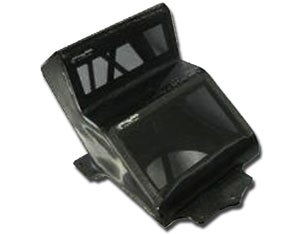 Got pipe? Then get an air intake that directs more air into the motor’s intake. Motor performance means working from both ends – intake and exhaust.
Got pipe? Then get an air intake that directs more air into the motor’s intake. Motor performance means working from both ends – intake and exhaust.A single tuned exhaust improves the sonic or pulse wave a two-stroke motor develops to pull in the oxygen and fuel charge and push it back into the crankcase on the upstroke. A two-stroke motor does not have cylinder head valves like a four-stroke motor, thus the tuned exhaust acts like a mechanical valve, relying on pulse waves to help control intake and exhaust, in collaboration with the piston skirt, reed cages and the cylinder head exhaust valve. It’s a perfect dance of timing.
To make the most of a tuned exhaust, ask the pipe builder if it has an efficient airbox to help the motor pull in fresh air with little restriction. If the pipe builder does not have an accompanying airbox, then quiz whose aftermarket airbox it recommends to work with the tuned exhaust. If the answer is none, or the stock airbox works fine, then do some research – check some reputable forums on the topic. A good source is to read racer results from the Rocky Mountain Snowmobile Hillclimb Association (RMSHA); often times a description (sponsor list) is given of their improved stocker snowmobile.
A clean unrestricted airbox is similar to installing a cold air kit on your gasoline or diesel powered pickup. Like adding an aftermarket exhaust to a “tower” – your pickup – it will only see its full potential with a cold air intake kit.
Resources for an airbox, or modifications to an existing airbox, can be found at SLP, Idaho Falls, ID; Cutler’s Performance Center, Orem, UT; MTNTK Performance, Ashton, ID; and Carl’s Cycle Sales, Boise, ID.
Plan on spending about US$150 and US$200.
One last note. Many performance shops also recommend that if a mountain snowmobile owner is adding a single tuned exhaust pipe with lightweight muffler and a free flowing air box, then adding high quality and precise reed cages to the intake completely rounds out the induction and exhaust performance, ensuring the motor is realizing its full potential in crankcase and combustion chamber fuel and oxygen management, ignition and spent fuel exhausting.
We recommend all three, if budget allows. At the very minimum, a single tuned exhaust as a must.
Clutches
This may seem not as obvious as the above mentioned skis, tuned exhaust and airbox, but to old school mountain climbers, installing aftermarket drive and driven clutches, such a Team Industries’ Team Tied clutch, for example, or installing advanced high altitude kits into the snowmobile’s existing clutches, is elementary. Mountain snowmobiles turn a long track, 150 to 160 something inches in length and now with Ski-Doo’s T3 Summit X at 174, clutch efficiency is crucial. With a clutch receiving the twisting forces from the crankshaft and relaying this to the chaincase and then down to the track drivers, the clutches must be strong enough to handle load, heat from snow and rider load, deep snow, and mountain ascents.
Backcountry Survival in Your Backpack
The biggest gain for dollar spent – the practical approach – is installing weights, springs and helixes that are specific to high altitude performance into the OEM clutches. Improving upshift, downshift and holding motor revolutions at peak/maximum is an absolute must and no-brainer for sweet and nasty (all good) mountain riding.
Resources for clutches or high altitude drive and driven clutch power performance kits can be found at SLP, Idaho Falls, ID; Cutler’s Performance Center, Orem, UT; MTNTK Performance, Ashton, ID; Kurt’s Polaris, Seely Lake, MT and in Missoula, MT; and Carl’s Cycle Sales, Boise, ID.
Aftermarket driven and drive clutches will cost about US$300 to US$500. Clutch kits to make your snowmobile’s existing clutches altitude happy will fatten your credit card debt about US$130 to US$175.
Max Your Performance Dollars
If you want to read a practical experience for the above, read our Upgrading an Arctic Cat M8000 Through Porting feature.
There are many other items we could cover, such as porting, big bore kits, shocks, runningboads, front suspensions and rear suspensions. You must decide what performance needs you want to tackle. The items we’ve listed best deliver improved performance at high altitudes without reaching the costs of superchargers or turbochargers.



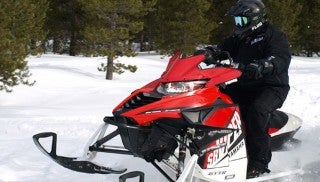

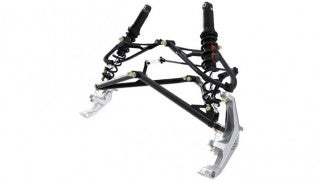


 Your Privacy Choices
Your Privacy Choices